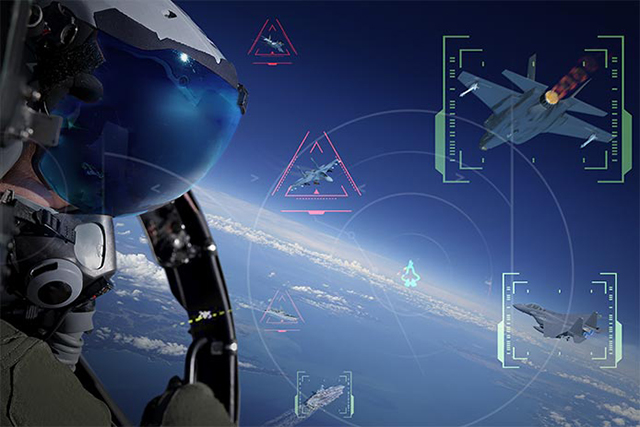
A pilot uses the Identification Friend or Foe interrogator to tell the difference between the “good guys” and “bad guys” in a contested environment. Identification Friend or Foe has run on Mode 4 since the 1960s. The U.S. Department of Defense AIMS program office has mandated the conversion for all systems to Mode 5 by June 30, 2020.
Slider: Ice, we’ve got a problem. I have four aircraft on radar. Four bogeys.
Iceman: Wood, we’ve got four bogeys.
Wolfman: Wrong, make that five!
First it was a pair of MiG fighter jets, then two pair…eventually, five. The final dogfight scene in the 1986 blockbuster “Top Gun,” depicts the dangers of misidentifying aircraft flying in close formation.
Fortunately, more than 30 years later, a new upgrade to today’s jets Identification Friend or Foe, or IFF, system will help pilots avoid dangerous situations like this one featured in “Top Gun”.
“This is a huge upgrade,” said Frank Whiston, director of IFF for Integrated Communication Systems at Raytheon Intelligence & Space, one of the four businesses that form Raytheon Technologies. “Mode 5, the new system, can better identify friendly aircraft from long-range distances, especially when they are flying in close formation.”
The IFF system identifies friendly forces, which reduces risk for fratricide, the killing of one’s own forces, and increases the pilot’s situational awareness. Identification Friend or Foe has run on Mode 4 since the 1960s. The U.S. Department of Defense AIMS program office has mandated the conversion for all systems to Mode 5 by June 30, 2020.
Mode 5 significantly improves the ability to identify and track friendly aircraft, providing increased situational awareness to command and control and combat ID functions. Mode 5 improvements include new cryptography, stronger security features, modern signal modulation techniques and greater data content. The increased data capacity enables encrypted transmission and supports new data formats, including National Origin codes and Platform Identification Numbers.
Mode 5 also includes lethal interrogations designed to prevent fratricide by providing a final challenge to a targeted platform prior to weapons engagement. Lethal interrogation formats elicit a Mode 5 response even when the platform is flying radio silent or “EMCOM”, short for emission control.
In 2019, Raytheon Intelligence & Space and Hanwha Systems signed a $170 million technical cooperation agreement to produce IFF Mode 5 systems across more than 40 types of air and maritime platforms for the Republic of Korea military.
When Whiston was describing these capabilities to a Republic of Korea colonel and his team, Whiston said the colonel remarked “Oh, like “Top Gun.”
“I had to think about it for a second and go back. I remembered the scene and said to him, “absolutely…just like “Top Gun,”” Whiston said.
There are three stages to identifying an aircraft as friend or foe: radar detection, antenna reception and IFF interrogation.
“An aircrew establishes themselves in a Combat Air Patrol waiting for an event that would trigger a response,” said Joe “Grip” Beissner, who flew the F-15E Strike Eagle in the U.S. Air Force and now works for Raytheon Intelligence & Space. “If the trigger is met, then the aircrew will engage the adversary using on-board sensors.”
“In a typical scenario, you are initially too far from the adversary to detect them on your own radar so you have to use off-board systems for situational awareness,” Beissner said. “As you close in on the threat, you transition to your own avionics, in this case your fire control radar, and you activate the IFF system.”
If a pilot is flying in an F-15, it would be equipped with an active electronically scanned array, or AESA, radar. The radar would detect an oncoming aircraft and signal to the IFF Electronically Steered Antenna. The antenna would pass the signal to the IFF Mode 5 system for interrogation.
“What you need in today’s environment is a ‘lack of friendly’ and a ‘positive hostile’ before you can engage,” said Beissner. “So when you activate IFF, you essentially are trying to elicit a response to find out whether you’ve got a good guy or a bad guy in front of you.”
Pilots sometimes fly in a state of radio silence. They disable their transponders so the aircraft doesn’t reply to any interrogations, which could potentially reveal them to detection by hostile forces who might be listening.
One of the biggest updates to IFF under Mode 5 is lethal interrogation, which enables the interrogating pilot to override another aircraft flying radio silent and activate their transponder to elicit a response to the new lethal interrogation format, enhancing fratricide prevention. It’s a pilot’s last steps in a shoot no shoot decision.
“This is probably the most important update to the system,” Whiston said. “IFF’s main purpose is to prevent fratricide. Lethal interrogation and the other upgrades under Mode 5 will save lives.”
Raytheon Intelligence & Space has installed and maintained IFF interrogators and transponders on more than 120 types of aircraft, ships and land vehicles around the world.
Learn more about Raytheon Intelligence & Space’s Communication & Navigation solutions.





















